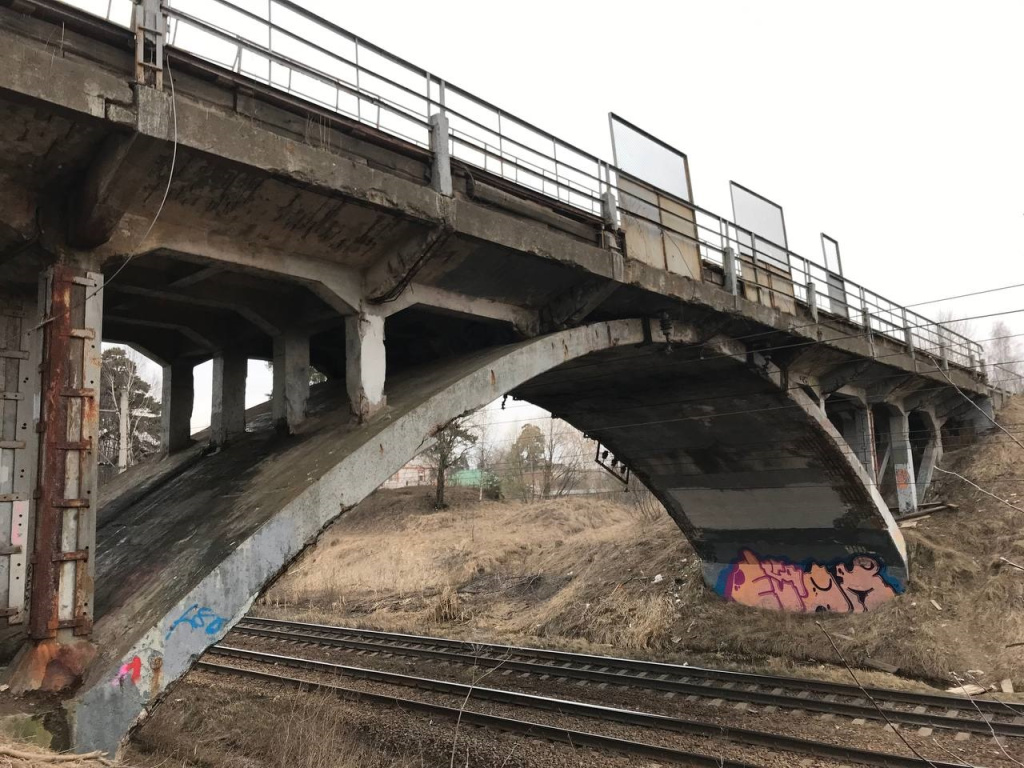 Svetlana Osokina
Svetlana Osokina
Final qualifying works and master's theses of SPbGASU students are devoted to topics relevant to St Petersburg, the Leningrad Region and other regions. Svetlana Osokina, a specialist's graduate of the Faculty of Civil Engineering, under the scientific supervision of Evgeny Kornylyev, a senior lecturer at the Department of Roads, Bridges and Tunnels, developed a project for the reconstruction of an overpass near the Martyshkino railway station in the area of the Northern Capital.
 Overpass near the Martyshkino railway station
Overpass near the Martyshkino railway station
The topic was proposed by the Committee for the Development of Transport Infrastructure of St Petersburg for students to complete in the 2022/2023 academic year.
We asked Svetlana what is remarkable about the overpass at the Martyshkino railway station and why such facilities need reconstructing.
– The overpass is located in the alignment of Zhora Antonenko and Svyazi streets and passes over the Baltic direction of the Oktyabrskaya railway. Initially, the Oranienbaum Electric Line (also known as ORANEL), the first suburban electric train project in the Russian Empire, was supposed to pass through it.
The construction of the overpass dates back to 1913–1914. Andrey Andreevich Kister was the chief engineer of the Oranienbaum line. In addition, at that time, the very young Boris Dmitrievich Vasilyev, the future largest specialist in the field of reinforced concrete structures, took part in the design. However, the main author of the overpass in Martyshkino was Robert Mayar, an outstanding Swiss bridge builder, one of the founders in the design of reinforced concrete bridges, who lived and worked in St Petersburg in those years.
By order of the Committee for State Control, Use and Protection of Historical and Cultural Monuments of St Petersburg dated 16 January, 2020, the overpass was recognized as an object of cultural heritage of regional significance. It is part of the ensemble "Bridges of the Oranienbaum Electric Line".
I believe that it is very important to preserve such structures, because they tell about how modern bridge building was born. Therefore, I've developed the project for the overhaul of the overpass without changing its dimensions.
– Please tell us about your project.
– An asphalt road runs along the overpass, which is widely used by residents of the city of Lomonosov. My goal was to solve a number of urgent problems: to ensure comfortable passage of vehicles and pedestrians, to give the construction an aesthetic appearance and to strengthen the structure, thereby increasing the life cycle of the facility.
The work began with the collection of initial data. I sent letters to the Committee for the Development of Transport Infrastructure of St Petersburg, to the St Petersburg Distance of Engineering Structures (operating organization of the Oktyabrskaya Railway), visited the Central State Archive of Scientific and Technical Documentation of St Petersburg, where I managed to see the technical and architectural designs of this overpass fr om 1913. Inspected the structure to clarify its dimensions and detect defects not indicated in the available documentation.
Then I considered three options for a major overhaul. All of them involved the installation of adapter plates, the replacement of the structure of the abutments and the bridge deck.
I chose the option of strengthening the surfaces of the supporting structures of the overpass with composite materials (CarbonWrap) with the restoration of the concrete surfaces of the elements of the superstructure, pillars and arches with repair compounds. This option is optimal from an economic point of view. In addition, it allows you to save the materials that were used in the construction of the overpass more than a century ago.
– Who helped you in your work?
– In the process of work, I talked with representatives of the Nanotechnology Center for Composites, a company that produces materials for strengthening construction projects. Employees advised me on the use of composite materials.
In addition, I received advice from the Malinovsky Reinforced Concrete Plant. This company is engaged in the development of drainage systems. The overpass does not have a longitudinal slope, so it was proposed to use double bottom drainage trays, which allows creating an internal slope of the trays.
I was consulted on a number of issues related to the technology of construction and installation works at the enterprise Baltic Coast Construction Company LLC.
Besides, I am also thankful to my colleagues from BaltMostStroy LLC, who shared their experience, ideas and knowledge. The acquired skills helped me in my work on the FQW.
St Petersburg State Budgetary Institution "Mostotrest" represented by the Deputy Director, Chief Engineer Yury Gennadievich Fedorov, provided great assistance. He told about this object, provided the documentation and analogues available in Mostotrest State Budgetary Institution for study, advised wh ere to go to find the missing materials.
Having collected all the necessary information, having coordinated my technical solutions with my supervisor, I completed the work. Evgeny Nikolaevich Kornylyev motivated me, helped me to cope with the most difficult tasks, to develop not only professionally, but also personally.
As a result, I defended my thesis with excellent mark. I hope that my solutions will be used in the development of the overpass overhaul project, and I will be able to see the result.